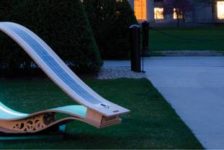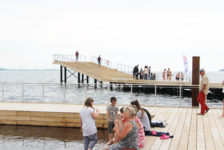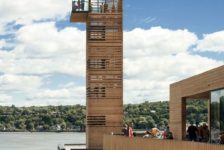Article by Selen Öztürk Elytra Filament Pavilion, a collaborative project in Victoria and Albert Museum, John Madejski Garden, London, England, United Kingdom Elytra Filament Pavilion, a biomimetic installation by Achim Menges, Moritz Dörstelmann, Jan Knippers and Thomas Auer, in the Victoria and Albert Museum’s John Madejski Garden, London. Can nature contribute to architectural designs? As we look through Elytra Filament Pavilion’s design techniques, the answer is definitely: YES! The pavilion was designed by imitating the structure of the wings of flying beetles. But WHY? The practice of learning from nature is called biomimicry. In the Elytra Filament Pavilion, the construction of this biomimetic design is inspired by the fibrous structures of the fore-wing shells of flying beetles known as elytra. Also, this design is an example of how knowledge and innovation can be achieved on both technical and design levels. [read more=”Read more” less=”Read less”]
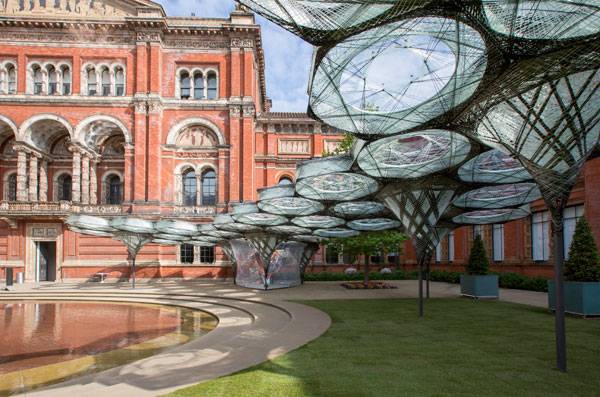
Elytra Filament Pavilion at the V&A Credit: Victoria and Albert Museum, London
A team of architects and engineers from the University of Stuttgart – Achim Menges and Moritz Dörstelmann as architects, Jan Knippers as structural engineer and Thomas Auer as climate engineer – made this installation for the Engineering Season of the Victoria and Albert Museum in London. This experimental pavilion has been opened to the public on the 18th of May, 2016, and it will be on view until the 6th of November.
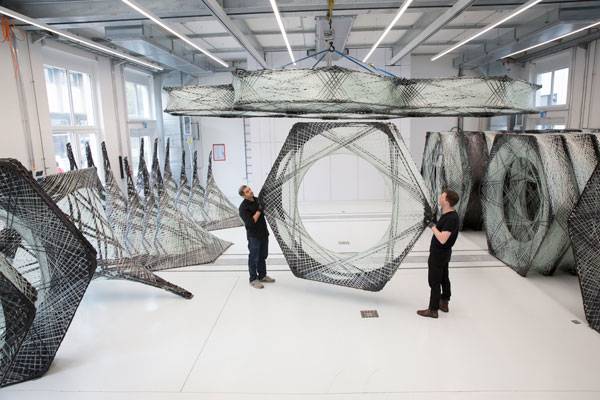
Components that will make up Elytra Filament Pavilion (c) Victoria and Albert Museum, London
The Elytra Filament Pavilion is the latest installation in the Victoria and Albert Museum’s courtyard. It is a result of four years of research on the integration of architecture, engineering, and biomimicry principles. The 200-square-meter structure consists of 40 hexagonal component cells and 7 supporting columns. Each cell weighs approximately 45 kg. The installation’s components have been fabricated by a computer-programmed Kuka robot in a four-month construction process at the University of Stuttgart and assembled on site in the V&A Museum’s John Madejski Garden.
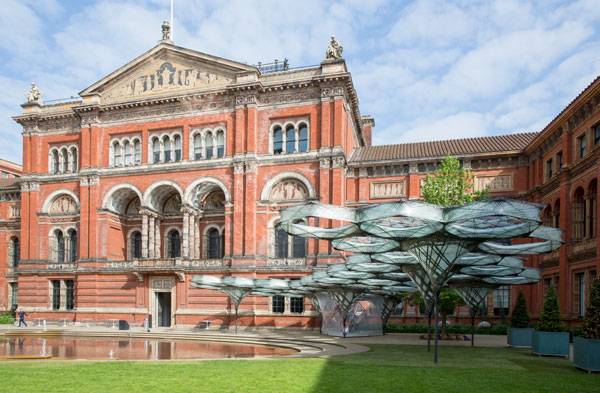
Elytra Filament Pavilion at the V&A. Credit: Victoria and Albert Museum, London
For the fabrication process, the designing team developed their own robotic procedures and processes themselves. The materials that are used to frame the components are transparent glass fiber and black carbon fiber. While glass fiber provides lightness, carbon fiber ensures the structural strength and stiffness of the system.
Architect Achim Menges explains the goal of this process: “
With Elytra Filament Pavilion we aim to celebrate a truly contemporary and integrative approach to design, engineering and production, resulting in a distinctive spatial and aesthetic experience. Based on the biological structure of beetles’ hardened forewings, we have created a novel architectural system that covers parts of the John Madejski Garden with an intricate, extremely lightweight structure made entirely from glass and carbon fibers.”
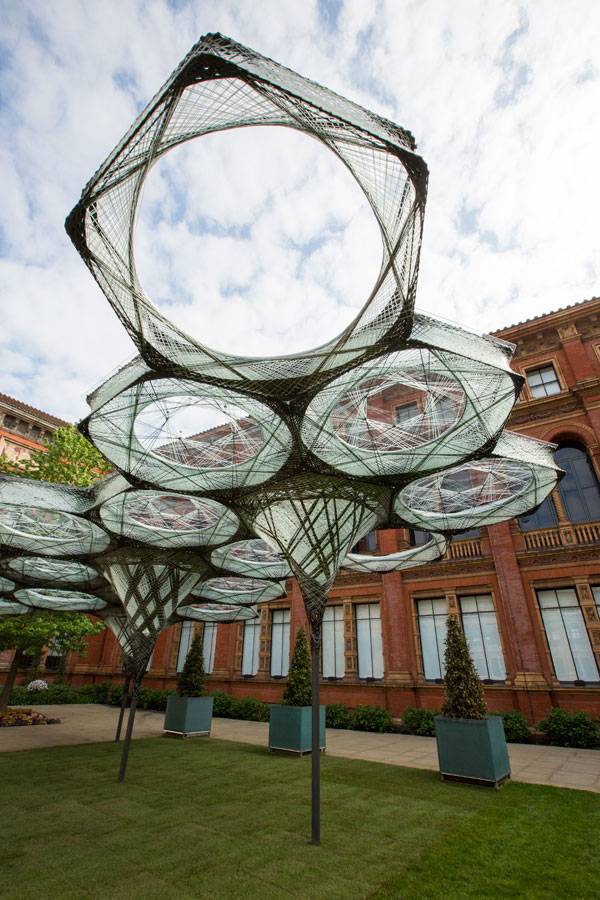
Elytra Filament Pavilion at the V&A. Credit: Victoria and Albert Museum, London
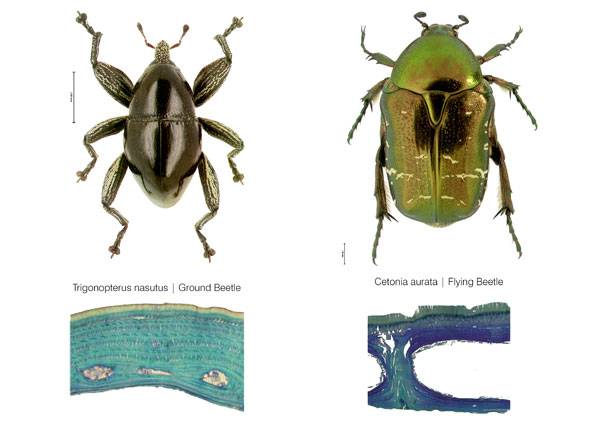
Comparison of internal elytron architecture in flying and flightless beetle. © Dr.Thomas van de Kamp, Prof. Dr. Hartmut Greven
In nature, all living creatures deal with some problems and they develop different skills to overcome them. If we analyze the skills they have improved, we can learn lots of beneficial things that may contribute to our designs. The elytra structure is suitable to be used as a role model for highly material-efficient constructions. These structures are stiff forewings of the beetles and they have been modified to protect the sensitive wings (alea) under them when they are at rest. Likewise, the created canopy forms resting spaces for people who are visiting the museum. This is how nature and our daily life are involved in an interaction. Moreover, with this wing structure it is possible to create lightweight constructions. Both the geometric morphology of the double-layered system which flying beetles have and the mechanical properties of the natural fiber composite that is used enable this lightness and diversified capacity as
Luis Eduardo Guisar Benitez explains in his article ‘
Understanding the Basic Principles of Organic Design’.
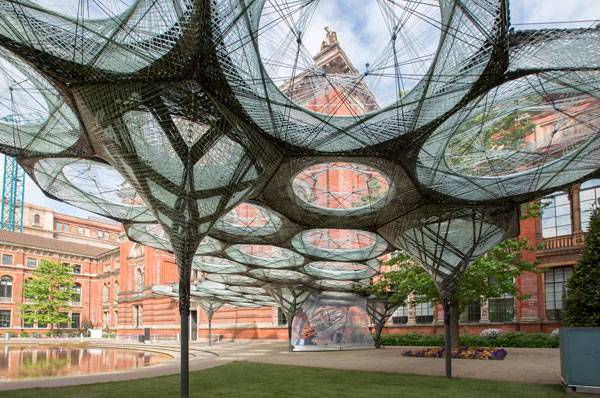
Elytra Filament Pavilion at the V&A. Credit: Victoria and Albert Museum, London
The pavilion evolves and changes according to the situation that it is in, as things do in nature! Real-time sensors were placed in the structure’s canopy fibers and according to anonymous data on how visitors use and move under the canopy, the structure responds to them. The setup of the robot and the lightness of the material allows the design team to have local production in the courtyard; thus new components will be fabricated, live, in the garden, by a Kuka robot, on specified days. On 17th June, 18th June and 22th September, visitors will be able to see the structure grow and change its configuration.
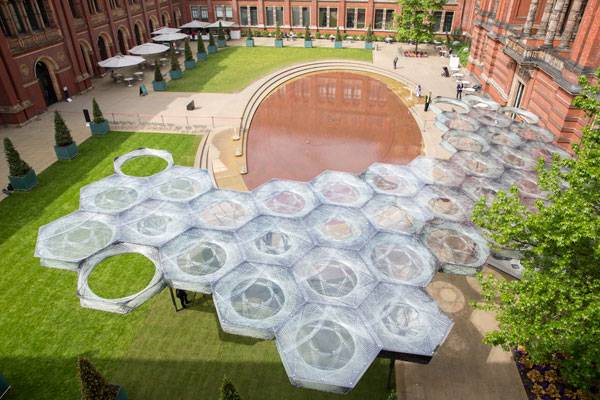
Elytra Filament Pavilion at the V&A
Credit: Victoria and Albert Museum, London
To sum up, by searching nature, understanding the structure of the fore-wing shells of flying beetles, learning the reasons they evolved in that way, and utilizing this research for the design of this pavilion, a team of architects and engineers from Stuttgart University put their signature on an important success.
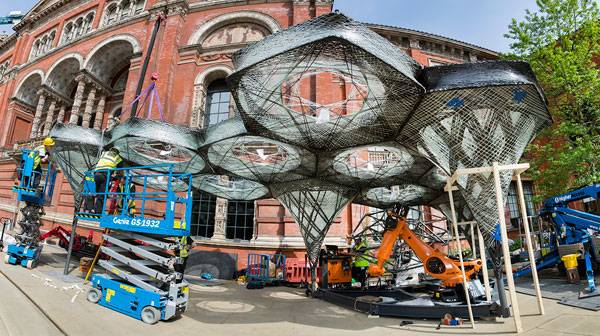
Elytra Filament Pavilion construction (c) Victoria and Albert Museum, London
There are lots of biomimetic designs and architectural installations that change our point of view of situations; but the elytra filament pavilion not only integrates biomimetic and architectural features, but also adds engineering principles to the design for the Engineering Season of the Victoria and Albert Museum. In Elytra Filament Pavilion, nature contributes some features to the design, which makes it unique in its own classification. The beetle-imitating structure and evolving cells proves this opinion. I strongly believe that nature can contribute more to us for new innovations. I am looking forward to visiting the pavilion and being there on the days that the structure evolves.
Would you like to visit and be a part of this evolutionary process?
CLICK TO COMMENT
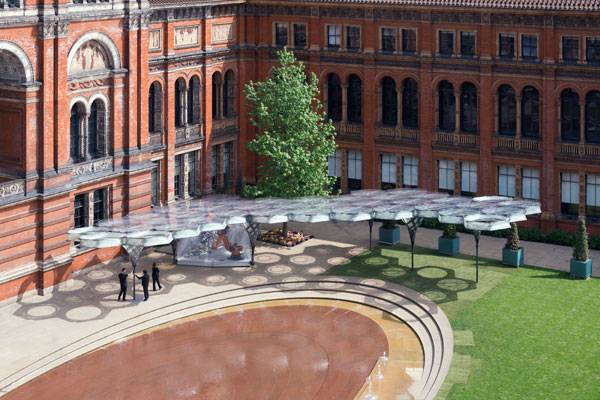
Elytra Filament Pavilion at the V&A. (c) NAARO
Full Project Credits For Elytra Filament Pavilion :
Project: Elytra Filament Pavilion Location: Victoria and Albert Museum, John Madejski Garden, London Created by: Achim Menges, Moritz Dörstelmann, Jan Knippers and Thomas Auer, in the Victoria and Albert Museum’s John Madejski Garden Construction Completion: 2016 Project Area: 200 square-meter Recommended Reading:
Article by Selen Öztürk[/read]
Published in Blog














